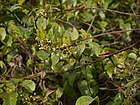Note: This is a project under development. The articles on this wiki are just being initiated and broadly incomplete. You can Help creating new pages.
Difference between revisions of "Tylophora indica"
(→Identification) |
|||
| (3 intermediate revisions by the same user not shown) | |||
| Line 5: | Line 5: | ||
==Parts Used== | ==Parts Used== | ||
| − | {{Parts Used| | + | {{Parts Used|Roots}}. |
==Chemical Composition== | ==Chemical Composition== | ||
| − | It contains the non-alkaloidal compounds isolated from Tylophora indica are kaempferol, quercetin, α- and β- amyrins, tetratriacontanol, octaosanyl octacosanoate, sigmasterol | + | It contains the non-alkaloidal compounds isolated from Tylophora indica are kaempferol, quercetin, α- and β- amyrins, tetratriacontanol, octaosanyl octacosanoate, sigmasterol.<ref name="chemical composition"/> |
==Common names== | ==Common names== | ||
| Line 33: | Line 33: | ||
==Identification== | ==Identification== | ||
===Leaf=== | ===Leaf=== | ||
| − | {{Leaf|||}}<ref name="Leaf"/> | + | {{Leaf|Ovate-Oblong to elliptic oblong|Heart shaped at base|Velvety Beneath when young}}<ref name="Leaf"/> |
===Flower=== | ===Flower=== | ||
| − | {{Flower||||}} | + | {{Flower|Oblong||Greenish-Yellow||Flowering season is June-February}} |
===Fruit=== | ===Fruit=== | ||
| − | {{Fruit||||||}} | + | {{Fruit|Ovoid||Lanceshaped|Follicle||Fruiting season is June-February}} |
===Other features=== | ===Other features=== | ||
| Line 70: | Line 70: | ||
<ref name="chemical composition">[https://ijpsr.com/bft-article/a-brief-phytopharmacological-overview-of-tylophora-indica-an-endangered-medicinal-plant/?view=fulltext#:~:text=The%20non%2Dalkaloidal%20compounds%20isolated,chloride%2C%20quercetin%20and%20kaempferol%202. Chemical constituents]</ref> | <ref name="chemical composition">[https://ijpsr.com/bft-article/a-brief-phytopharmacological-overview-of-tylophora-indica-an-endangered-medicinal-plant/?view=fulltext#:~:text=The%20non%2Dalkaloidal%20compounds%20isolated,chloride%2C%20quercetin%20and%20kaempferol%202. Chemical constituents]</ref> | ||
<ref name="Plant family">Karnataka Aushadhiya Sasyagalu By Dr.Maagadi R Gurudeva, Page no:29</ref> | <ref name="Plant family">Karnataka Aushadhiya Sasyagalu By Dr.Maagadi R Gurudeva, Page no:29</ref> | ||
| − | <ref name="Leaf"> | + | <ref name="Leaf">Kappatagudda - A Repertoire of Medicianal Plants of Gadag by Yashpal Kshirasagar and Sonal Vrishni, Page No. 380</ref> |
<ref name="Common names">[https://sites.google.com/site/indiannamesofplants/via-species/t/tylophora-indica Common names]</ref> | <ref name="Common names">[https://sites.google.com/site/indiannamesofplants/via-species/t/tylophora-indica Common names]</ref> | ||
<ref name="How to plant/cultivate">[Cultivation]</ref> | <ref name="How to plant/cultivate">[Cultivation]</ref> | ||
Latest revision as of 17:35, 20 May 2021
Indian ipepac is a slender, hairy or glabrous branching climber, producing stems up to 1.5 metres tall from a short rhizome that is 3 - 4mm thick. The plant is used locally as a source of fibre and medicines. It belongs to Asclepiadaceae.[1]
Contents
- 1 Uses
- 2 Parts Used
- 3 Chemical Composition
- 4 Common names
- 5 Properties
- 6 Habit
- 7 Identification
- 8 List of Ayurvedic medicine in which the herb is used
- 9 Where to get the saplings
- 10 Mode of Propagation
- 11 How to plant/cultivate
- 12 Commonly seen growing in areas
- 13 Photo Gallery
- 14 References
- 15 External Links
Uses
Asthma, Bronchitis, Dysentery, Diarrhoea.[2]
Parts Used
Chemical Composition
It contains the non-alkaloidal compounds isolated from Tylophora indica are kaempferol, quercetin, α- and β- amyrins, tetratriacontanol, octaosanyl octacosanoate, sigmasterol.[3]
Common names
| Language | Common name |
|---|---|
| Kannada | ಅಡುಮುಟ್ಟದಗಿಡ Adumuttadagida, ಅಂತಮೂಲ Antamula, |
| Hindi | Antamul, Jangli pikvan |
| Malayalam | Vallippala |
| Tamil | Kalutai-p-palai, Naccaruppan |
| Telugu | Kakkupala, Meka meyyani aaku |
| Marathi | Khadaki rasna, Pitamari |
| Gujarathi | |
| Punjabi | |
| Kashmiri | |
| Sanskrit | Antrapachaka, Latakshiri |
| English | Indian ipecac, Indian ipecacuanha |
Properties
Reference: Dravya - Substance, Rasa - Taste, Guna - Qualities, Veerya - Potency, Vipaka - Post-digesion effect, Karma - Pharmacological activity, Prabhava - Therepeutics.
Dravya
Rasa
Guna
Veerya
Vipaka
Karma
Prabhava
Habit
Identification
Leaf
| Kind | Shape | Feature |
|---|---|---|
| Ovate-Oblong to elliptic oblong | Heart shaped at base | Velvety Beneath when young |
Flower
| Type | Size | Color and composition | Stamen | More information |
|---|---|---|---|---|
| Oblong | Greenish-Yellow | Flowering season is June-February |
Fruit
| Type | Size | Mass | Appearance | Seeds | More information |
|---|---|---|---|---|---|
| Ovoid | Lanceshaped | Follicle | Fruiting season is June-February |
Other features
List of Ayurvedic medicine in which the herb is used
Where to get the saplings
Mode of Propagation
How to plant/cultivate
A plant of mainly lowland elevations in the tropics, though it can be found at elevations up to 900 metres.[6]
Commonly seen growing in areas
Common along the coast on sandy soils, Sandy coconut plantations.
Photo Gallery
References
- ↑ Karnataka Aushadhiya Sasyagalu By Dr.Maagadi R Gurudeva, Page no:29
- ↑ Indian Medicinal Plants by C.P.Khare
- ↑ Chemical constituents
- ↑ Common names
- ↑ Kappatagudda - A Repertoire of Medicianal Plants of Gadag by Yashpal Kshirasagar and Sonal Vrishni, Page No. 380
- ↑ [Cultivation]
External Links
- Ayurvedic Herbs known to be helpful to treat Asthma
- Ayurvedic Herbs known to be helpful to treat Bronchitis
- Ayurvedic Herbs known to be helpful to treat Dysentery
- Ayurvedic Herbs known to be helpful to treat Diarrhoea
- Herbs with Roots used in medicine
- Herbs with common name in Kannada
- Herbs with common name in Hindi
- Herbs with common name in Malayalam
- Herbs with common name in Tamil
- Herbs with common name in Telugu
- Herbs with common name in Marathi
- Herbs with common name in Sanskrit
- Herbs with common name in English
- Habit - Climber
- Index of Plants which can be propagated by Seeds
- Herbs that are commonly seen in the region of Common along the coast on sandy soils
- Herbs that are commonly seen in the region of Sandy coconut plantations
- Herbs





